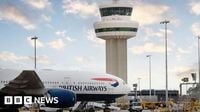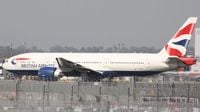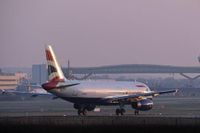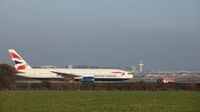A British Airways Boeing 777 jet was preparing for takeoff from Gatwick Airport when a co-pilot's unfortunate mix-up of his left and right hands led to a dramatic incident on June 28, 2024. The co-pilot accidentally pulled back on the left thrust lever instead of the right, resulting in a reduction of the aircraft's thrust and causing the brakes to catch fire. This prompted the pilots to execute a ‘high-speed emergency stop’ while the plane was traveling at nearly 190 mph.
According to a report released by the Air Accidents Investigation Branch (AAIB), the incident forced authorities to temporarily close Gatwick Airport, leading to the cancellation, delay, and diversion of dozens of flights. Fortunately, none of the 334 passengers or 13 crew members aboard the aircraft, which was bound for Vancouver, Canada, were injured.
The AAIB report detailed that the co-pilot, who had logged over 6,000 hours of flying time and had recently returned from a two-week break, was feeling ‘well-rested’ and ‘fine.’ However, he could not identify why he had mixed up his left and right hands during such a critical moment.
As the aircraft began its takeoff roll down Runway 26L, the co-pilot was supposed to move his left hand away from the thrust levers as the plane approached V1, the speed at which the aircraft is committed to takeoff. Instead, he unintentionally pulled back on the left thrust lever, which is typically used to control engine power. The AAIB described this error as an ‘action slip,’ a common phenomenon where a habitual action is performed incorrectly.
"The V1 callout was a normal prompt for the co-pilot to move his left hand during the takeoff roll, while preparing to pull back on the control column with his right hand," the report stated. "However, he unintentionally pulled his left hand back instead." This resulted in a situation resembling a rejected takeoff maneuver rather than a standard ascent. The report further noted that there was no obvious reason for the co-pilot to have performed this action, as he had not changed aircraft types or practiced similar maneuvers recently.
The aircraft's thrust reduction occurred at a critical point in the takeoff sequence, just as the commander of the flight was calling for the plane to start climbing. The co-pilot even attempted to push the thrust lever forward again briefly but ultimately decided to abort the takeoff entirely. The commander was monitoring the situation but did not have enough time to intervene before the decision was made to reject the takeoff.
After the incident, Gatwick Airport's rescue and firefighting service quickly responded to extinguish the fire caused by the hot brakes on the right main landing gear. A spokesperson from Gatwick stated, “Safety is our top priority and the dedicated airport fire service swiftly attended to support the aircraft.” The airport was closed for about 50 minutes, resulting in at least 23 flights being canceled and many others delayed.
British Airways acknowledged the incident, stating, “Our pilots took the precautionary decision to cancel take-off due to a technical issue. Safety is always our top priority and we apologize to customers for the inconvenience caused.” The airline had recently issued a safety notice reminding pilots to pause and cognitively consider their required actions before executing them, underscoring the importance of focus during operations.
Travel expert Simon Calder noted that the incident caused significant disruption, with at least 12 flights, including an Emirates A380 from Dubai, being diverted to Brussels. The AAIB's findings highlighted the need for ongoing training and vigilance among flight crews to prevent similar occurrences in the future.
In summary, the June 28 incident serves as a stark reminder of the complexities and pressures faced by pilots during takeoff. While the co-pilot's error did not result in injuries, it did lead to substantial operational disruptions, emphasizing the critical nature of maintaining focus and clarity in high-stakes environments.







